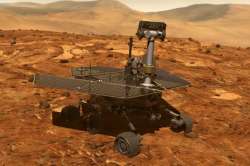Martian dust storm recedes; scientists hopeful to hear back from Opportunity Rover
Scientists at NASA's Jet Propulsion Laboratory (JPL) in the US believe that the rover will soon receive enough sunlight to automatically initiate recovery procedures, if it is not damaged.

A global dust storm that engulfed Mars, halting operations for NASA's Opportunity rover, continues to abate, raising scientists' hopes to hear back from the 15-year-old, solar-powered probe.
Scientists at NASA's Jet Propulsion Laboratory (JPL) in the US believe that the rover will soon receive enough sunlight to automatically initiate recovery procedures, if it is not damaged.
To prepare, the Opportunity mission team has developed a two-step plan to provide the highest probability of successfully communicating with the rover and bringing it back online.
"The Sun is breaking through the haze over Perseverance Valley, and soon there will be enough sunlight present that Opportunity should be able to recharge its batteries," said John Callas, Opportunity project manager at JPL.
When the tau level -- a measure of the amount of particulate matter in the Martian sky -- dips below 1.5, researchers will attempt to communicate with the rover by sending it commands via the antennas of NASA's Deep Space Network.
"Assuming that we hear back from Opportunity, we will begin the process of discerning its status and bringing it back online," said Callas.
The dust storm on Mars was first detected May 30m and the rover's last communication with Earth was received June 10.
Opportunity engineers are relying on the expertise of Mars scientists analysing data from the Mars Color Imager (MARCI) aboard NASA's Mars Reconnaissance Orbiter (MRO) to estimate the tau near the rover's position.
"The dust haze produced by the Martian global dust storm of 2018 is one of the most extensive on record, but all indications are it is finally coming to a close," said MRO Project Scientist Rich Zurek at JPL.
"MARCI images of the Opportunity site have shown no active dust storms for some time within 3,000 kilometers of the rover site," said Zurek.
With skies clearing, mission managers are hopeful the rover will attempt to call home, but they are also prepared for an extended period of silence.
"If we do not hear back after 45 days, the team will be forced to conclude that the Sun-blocking dust and the Martian cold have conspired to cause some type of fault from which the rover will more than likely not recover," said Callas.
At that point, the team will report to NASA HQ to determine whether to continue with the strategy or adjust it.
Even if the team hears back from Opportunity during either phase, there is no assurance the rover will be operational.
The impact of this latest storm on Opportunity's systems is unknown but could have resulted in reduced energy production, diminished battery performance, or other unforeseen damage that could make it difficult for the rover to fully return online